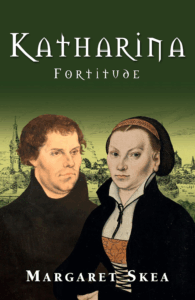Behind the Reformation
Katharina Luther series by Margaret Skea

These books about Katharina von Bora, Martin Luther’s wife, show an incredibly vivid combination of informative history and living personalities.
Katharina Deliverance
The first volume tells how the unwanted half-orphan is incarcerated as a child in a strict convent. Through smuggled pamphlets, Katharina and other novices hear of Martin Luther’s revolutionary suggestion that priests and nuns need not be condemned to a life of celibacy. In a breathtaking, night-time, cloak-and-dagger operation, they escape.
But adjusting to a life of freedom in the world isn’t easy. Where can a single young woman, who’s been rejected by her family, live? How can she earn her keep? Her convent friends find work as a teacher or get married off to promising young men or frustrated widowers. Katharina falls in love with an eligible young man, but he leaves her hanging – a slight from which she never fully recovers. But she has a mind of her own; she’s devout, intelligent, well-educated and full of initiative. Surely she will find her way in life.
When a pastor acquaintance accosts her indecently and insists she should marry him, she pushes him off. ‘From the first moment we met, I thought you avaricious, hypocritical and ungenerous,’ she asserts. ‘Now I see that you are lustful also. You do no credit to your profession, and I despise you for it.’
But she fears Martin Luther will insist on the marriage. Katharina turns to a friendly university lecturer for help. Initially, he tries to justify her suitor as ‘a doctor and pastor of sound doctrine’ and therefore a valid match, but she blurts out:
‘It is not his profession, nor his intellect that offends me, for both are admirable. Were you or … Dr Luther to seek my hand, I would not refuse.’
It’s out. And she can’t take it back. And when this rash outburst comes to the ears of the brilliant Bible scholar and theologian – the socially incompetent, careless, unpractical, avowed celibate Dr Luther – he ends up proposing to Katharina and winning her hand.
Katharina Fortitude
The second book elaborates on their married life. She tidies up and expands their home, the vast, derelict “Black Cloister”; manages the servants and finances; cares for guests, students, relatives, and four orphaned children. And she bears six children to Martin.
Outbreaks of plague cause havoc in the region and many deaths; Katharina cares for the victims as best she can. Wars erupt, and she finds herself tending not only their own vegetable garden but being responsible for other farmlands.
Although the book is about Katharina, we gain insight into Martin Luther’s character and life. He is initially at loggerheads with the Roman Catholic Church over the sale of indulgences, but later concerning theological matters, such as justification by faith alone, as well as the role of the Bible, the Pope, the sacraments, the priesthood of all believers and the requirement of celibacy for priests and nuns.
Theological disputes also arose among Martin’s colleagues and internationally; they quibbled over what to us, in retrospect, seemed like minor details. All in all, the great doctor comes over as a stubborn, uncompromising zealot for the Truth. Partly due to careless habits, his health deteriorates, and one of his disputational journeys proves too much for him. Katharina suddenly has to cope alone.
The narrative is interspersed by short jumps to a future scene, in which Katharina’s children are adult. They care for her after she suffers multiple injuries when her carriage careers off the road and she is thrown out. Her mind is confused. She relives events of her youth, causing much distress to her loving offspring. The book ends with her gathering her children close:
Looking beyond them to the light, I say, ‘I can see heaven opened, and in the midst of the great throng I hear your father’s tenor voice ringing out, “Worthy is the lamb who was slain…” and soaring above it Magdalena’s soprano, “…to receive power and wealth and wisdom and strength…”’
For the first time in months my voice is strong and true, filling the room to overflowing with music as I join in the song’s climax, ‘…and honour and glory and praise.’ As the notes die away, I see a path opening through the crowd. I see a throne, and Jesus, standing, his arms spread wide. And I hear a voice, calling, ‘The Spirit and the Bride say, “Come”.’
Conclusion
Margaret Skea succeeds in opening the door both on the historic and theological environment in sixteenth century Saxony, as well as the thoughts and feeling of Katharina von Bora and her husband, the reformer Martin Luther. The prose is lively and very readable.
Old Wives’ Tales also reveals the characters and experiences of eighteenth century church leaders’ wives.




Looking for a fast track to the winner’s circle? Dafabetwin might be your ticket. Interface is slick, and I’ve had decent luck (knock on wood!). Give it a shot and see if lady luck is on your side. Your winning starts here: dafabetwin.